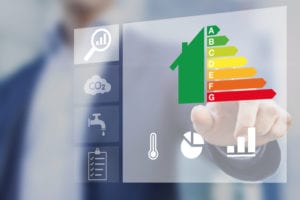 Andrew Sparrow, Head of Energy and Sustainability, advises how Platinum Facilities can help clients reduce energy costs, in an article originally published in the April 2021 edition of FMJ Magazine.
Andrew Sparrow, Head of Energy and Sustainability, advises how Platinum Facilities can help clients reduce energy costs, in an article originally published in the April 2021 edition of FMJ Magazine.
Businesses know that their ability to prosper today hinges upon responses to the challenges of a carbon-constrained world and an array of other issues on the sustainability agenda. Energy is a top priority, not only to reduce carbon emissions but to operate buildings more efficiently and to save money.
Understanding the energy performance of the building through accurate data collection and analysis is a precursor for energy audits, which allow the identification of energy and sustainability improvements. Carbon Zero audits can also be undertaken, determining the best and most effective ways of achieving zero carbon emissions, in compliance with the Paris Agreement.
Reducing Energy Consumption
We aim to not only reduce the energy and water consumption in commercial buildings, but to also reduce the carbon emissions. The easiest and cheapest ways of lowering carbon emissions are firstly to procure Green Electricity and secondly, to reduce the use of gas fired boilers. Replacing boilers with ground or air source heat pumps minimises gas consumption and when the electricity is sustainable, the building’s emissions will be reduced to zero. Where suitable external space is available, we can also install wind turbines and solar panels to reduce the dependence on grid electricity. Even if the electricity is green, we still want to minimise its use and the associated costs.
The lighting in an average commercial building uses 40% of its electricity consumption. This can be greatly reduced by replacing conventional with LED lighting and by improving the lighting controls. Over 70% of the lighting’s energy consumption will be saved in a typical refit.
Of the remaining 60% of the building’s energy consumption, about two thirds is consumed by the Heating, Ventilation and Air Conditioning (HVAC). The opportunity to improve the efficiency and building performance exists in most buildings and the key performance enhancer is upgrading the Building Management System (BMS). By rewriting the strategy within a BMS with energy efficiency in mind it turns it into a Building Energy Management System (BeMS) – generating substantial energy savings.
As an example, if you control a building’s temperature to 22°C, the heating system will heat it up to, and eventually over, 22°C. This will then bring on the cooling system, which will bring down the temperature to 22°C and eventually overshoot it – so that the temperature is again lower than 22°C. This will bring the heating back on, etc. with the heating and cooling systems fighting each other ad infinitum.
We utilise two setpoints one for the heating and one for the cooling, with a deadband in between the two. The larger the deadband the better for energy efficiency. For instance, a heating set point of 20°C and a cooling set point of 24°C, results in a deadband of 4°C. The heating heats up to 20°C and switches off and even if it does slightly overshoot and heats up to 21°C, the cooling won’t come on until the temp rises to 24°C. If the temperature remains within this 4°C deadband the heating and cooling will remain off, saving energy. We have saved over 50% of the HVAC energy in many buildings just by using this procedure.
There are a lot of other quick wins for energy efficiency, the most obvious of which is ensuring the operation of the systems coincides with the usage of the building. It is surprising that significant numbers of building systems operate continuously 24/7, when there are no occupants overnight or at the weekend. Simple software changes can quickly help optimise a building, but in the medium to long-term the big game changer is getting all of the building’s control systems working together.
Remote Building Monitoring
A data analytics system can be remotely connected to a building’s plant and lighting control systems via an Energy and Controls Bureau, to monitor performance. The remote building monitoring system analyses large amounts of data on a continuous basis and looks for inefficiencies and ways to improve the performance of facilities, reducing energy consumption, carbon emissions and increasing the life of the assets. By matching time schedules to occupancy and controlling the speeds of pumps, fans etc. we can minimise the building’s consumption, turning it into a Smart Building.
When it is cold enough, using cold external air to cool down the building is a very effective and cheap method. It is called free cooling and can be utilised as the first stage of cooling, rather than using mechanical cooling.
Improving Efficiencies
 Energy audits/ surveys of each building also identify inefficient plant and systems and allow recommendations for improvements. These can include the replacement of air handling unit fans with EC plug fans, replacing air filters with energy efficient replacements, matching plant running and implementing optimum start and stop, where the BeMS holds off plant start times and switches off plant early. Reviewing energy savings and building performance improvements on at least a quarterly basis ensures a continuous improvement methodology with next stage planning.
Energy audits/ surveys of each building also identify inefficient plant and systems and allow recommendations for improvements. These can include the replacement of air handling unit fans with EC plug fans, replacing air filters with energy efficient replacements, matching plant running and implementing optimum start and stop, where the BeMS holds off plant start times and switches off plant early. Reviewing energy savings and building performance improvements on at least a quarterly basis ensures a continuous improvement methodology with next stage planning.
An Energy Bureau will undertake energy procurement and bill validation, ensuring the best/ cheapest tariffs and that bills are correct. They are able to monitor the energy consumption of the building and target its performance ensuring compliance with all energy legislation and benchmarks.
Platinum Facilities’ Energy and Sustainability team have a complete all-encompassing demand and supply side offering. We undertake energy audits and surveys to identify energy and sustainability improvements and can implement these recommendations through our project management capability. Utilising remote building monitoring via our Energy and Control Bureau, we provide clients with the reassurance that their buildings are being analysed continually, to allow operational improvements to be made. This supports compliance, business continuity planning, cost savings, building operational efficiency and reduces the need for travel to sites, also saving carbon.
The Government has committed the UK to be Net Zero Carbon by 2050. At Platinum Facilities, we believe that this can be achieved much more quickly and have committed ourselves to become Carbon Neutral by 2030. M&E service providers can help their clients to improve their ESG (environmental, social, and governance) and start their Zero Carbon journey. Every client will get there differently, and in a different time frame, but we can help them determine how they can do it and what commitments they will need to make.
To find out how we can help you improve your ESG, please Contact Us.
